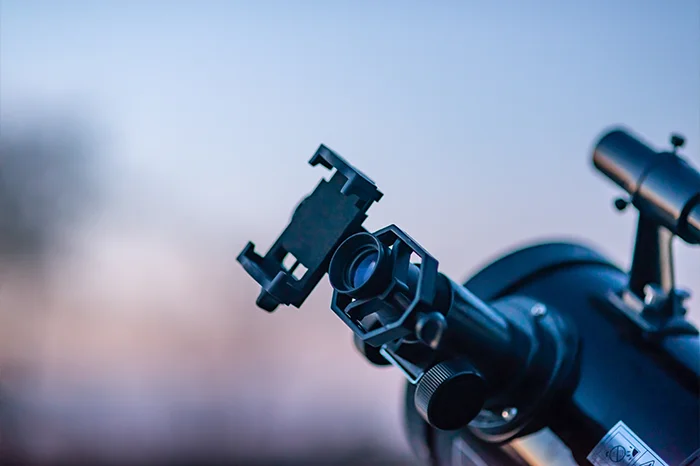Smartphone astrophotography. How to capture the stars in the photo?
Smartphone astrophotography - what is it all about?
We chose this topic to show you that it is possible to take beautiful astronomical photos not only with expensive professional cameras or expensive telescopes, but also with the available models of smartphones and telescopes - anyone can take on the role of an astrophotographer.
Astrophotography with a smartphone is nothing more than taking pictures of the sky and its elements, using a mobile phone camera. It may seem strange, but nowadays smartphones have increasingly better cameras and features that allow them to take photos of unimaginable quality.

How to start your adventure with phone astrophotography?
As a foundation for astrophotography, you need a telescope. On the market, there are both telescopes with tripods of fully manual, steerable construction and those that use GPS technology. However, if we are thinking about astrophotography with a phone, it will be easier to opt for a telescope with a manual tripod. That way, we won't need a large budget to take our first photos of the stars.
Some telescopes are equipped with a holder for attaching a smartphone to the eyepiece. But if you do not have such an adapter, it will be necessary to purchase one.
Once we have a telescope, it is helpful to have an astrophotography app. There are various types of apps on the market, which are perfect for taking our first photos. The application allows us to see the sky above our head in real time, and displays a lot of information about stars, planets, moons, etc. It allows us to quickly locate the object of our interest and point our telescope, without the need to study the basics of astronomy.
Night sky photography involves choosing a location with as little light pollution as possible, away from cities and light sources. There are special maps available online that show where the best places to go for night photography are.


How to take a picture of the Moon with a phone? - setting up the telescope and camera
Before taking pictures with your phone, make sure that the focus in the telescope's eyepiece is set correctly. We can do this by pointing it at a bright star and adjusting the focus until the star seen in the eyepiece is clear.

Now it's time for camera settings. An important aspect is to set the exposure and ISO sensitivity properly to get the best possible image. Astrophotography is quite a specific field and requires a lot of knowledge and experience in this field.
The exposure triangle is a key concept in photography that involves the relation between shutter speed, aperture and ISO sensitivity. Understanding how these settings affect an image can help you take better pictures. When using a telescope, we have no control over the aperture, as this value is mostly fixed for a given model. As for the other parameters, most of the new smartphones have the ability to set them in manual mode.
For the Moon and close planets, you can use a slower shutter speed and lower ISO to capture details. Star photography requires using a slower shutter speed and higher ISO to catch more light. It is important to remember, that by increasing the shutter speed, you will start to capture the Earth's rotation in the photo and the objects will "run away," creating distinctive lines. In addition, as the focal length available for our telescope increases, this phenomenon will intensify. This should be corrected by reducing the shutter speed. Nevertheless, we recommend that you read about these aspects in online forums or get in touch with more experienced astrophotographers.


After setting up the camera and placing the telescope on a tripod, it's high time to take a picture. It's a good idea to use a self-timer with a fairly long time delay. This gives a moment for the telescope to stabilize on the tripod and stand completely still, thus allowing the camera to take sharp and blur-free pictures.
Astrophotography - photo editing
In the era of digital photography, it is worth taking advantage of the benefits of the "digital darkroom". We are talking about photo editing programs. They will allow you to improve sharpness, remove defects due to imperfections in the optics of the telescope, change color saturation, brightness, contrast, and, above all, remove noise caused by high ISO sensitivities, required for night sky photos. With proper processing, we can not only improve the photos, but also give them the right character according to our vision.
Astronomical photos - can everyone take them?
To sum up, astrophotography is a field that, on the one hand, requires the right equipment and technical knowledge, but thanks to modern phones, advances in technology and increasingly available telescopes, amateurs can also take the plunge into astrophotography. After a few attempts and further education in this field, you will definitely be able to take great photos. At the same time, it is worth remembering that astrophotography is also a beautiful experience for the mind, it attracts attention and allows us to understand that our place in the universe is small, but at the same time magical.
Have a successful shooting!
Check out our similar entries:





